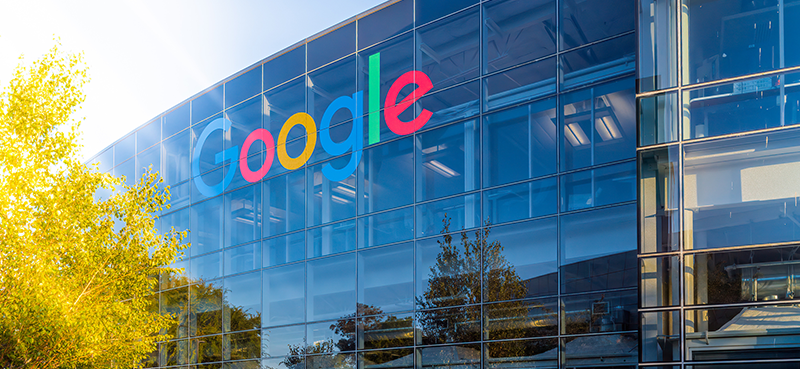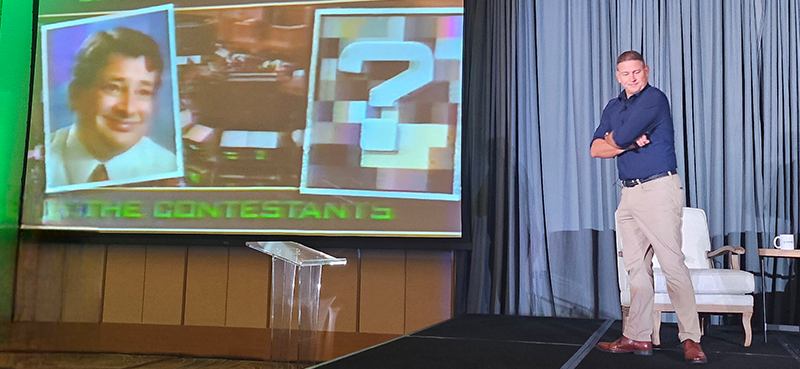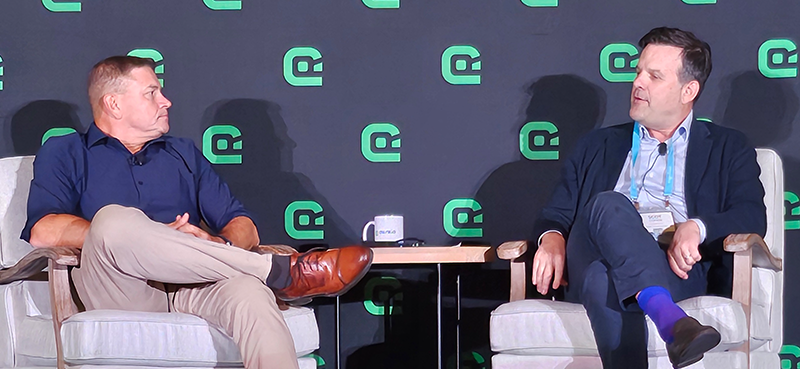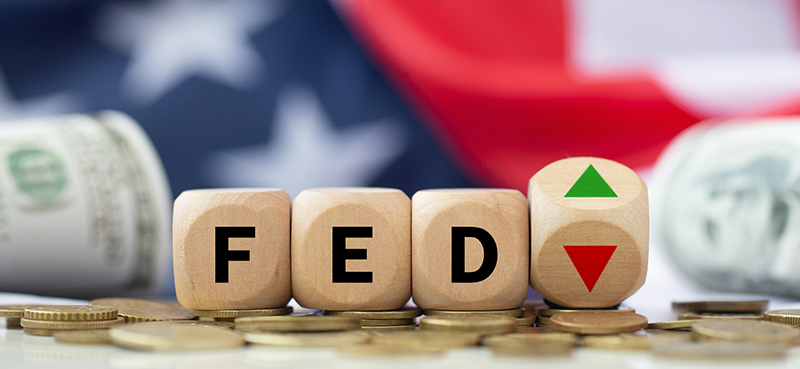Frank Curzio
The market sectors to buy—and avoid—now
Happy belated Halloween!
Today’s show starts with a rant about how times have changed since I was a kid… and why I’m worried kids can’t have fun anymore.
Turning to the markets… I break down what to expect from tomorrow’s Fed meeting… how long I expect the current rally to last… and why the latest jobs data should kill any optimism about the Fed turning dovish. I also dig into the booming market for HELOC loans… and what it means for the economy.
We’re still in a bear market, but that doesn’t mean you should be selling everything. I break down exactly which sectors investors should be buying right now… which ones to avoid… and the best strategy to profit from the ongoing volatility in stocks.
Wall Street Unplugged | 965
The market sectors to buy—and avoid—now
Announcer: Wall Street Unplugged looks beyond the regular headlines heard on mainstream financial media to bring you unscripted interviews and breaking commentary direct from Wall Street right to you on main street.
Frank Curzio: How’s it going out there? It’s November 1st. I’m Frank Curzio, host of the Wall Street Unplugged podcast, where I break the headlines and tell you what’s really moving these markets. Boy, I had a great Halloween. I don’t know about you, Halloween’s just so different today than it was back in my day. Going trick or treating, went over a friend’s house with the grandfather for the first time, shook his hand, and one minute in, he’s like, watch the Fentanyl with the candy. Like relax. Everybody just watches everything these days. But it’s just paranoid, I don’t know if that leads to people not liking Halloween as much, especially if you’ve got old… There’s a lot of older people in Florida, everybody knows that. And I don’t know, if I had to guess when it comes to Halloween, there’s no stats on this or anything, but I would say there’s probably, at least in Florida, a small sample from where I live, at least 30% of the houses don’t participate anymore, just don’t like it.
Frank Curzio: In my neighborhood, I’ve said the past couple years, they put up a sign: You can only trick or treat from six to 8:00 PM. Kids can’t have fun, right? I usually take the sign and chuck it in the lake all the time. I don’t know if they know it’s me; I don’t care. I’m leaving the neighborhood soon, but it’s very, very frustrating. But just shut your lights off if you don’t want anyone to bother you. It’s that simple. They’re not going to come up and ring your bell, but having restrictions like kids having fun… I mean, you don’t want them knocking the doors at 11:00 PM, I get it. But 9:00, 9:30 kind of makes sense. And again, shut your lights off, you can go to bed earlier than that. But man, you don’t see as many houses participate, as many neighborhoods participate. We used to have the greatest neighborhood ever, and now nobody trick or treats.
Frank Curzio: We actually go to a different neighborhood, and some neighborhoods get it right; they have parties. All the kids go trick or treating in like a 10 block radius, and the wives will take them, and the husbands hang out and drink and have fun, and then the husbands take them on the next round. And every house has a side table where they offer Jell-O shots for the adults, which is cool. They’re just fun drinking, everyone’s dressed up, and the parents are dressed up. My youngest is dressed up as a clown, not too much makeup on her face, but she wore an awesome outfit, looked cute. My 14-year-old, man, she is tall for her age. And I have to tell you, if you have younger kids right now, especially daughters, 13, like late 13, 14, 15, holy cow. Man, I’m seeing that now.
Frank Curzio: But I would say 85, 90% of the costumes all are very, very sexy, and they make them that way. I don’t know if it’s social media and everybody wants to see that way, but so much for kids dressing up, or painting their faces. I mean, they don’t really wear masks. They wear these sexy outfits. And I mean, my daughter went as a police officer, and I’m like, pull it down a little bit, and pull the top up a little bit, but she may have been the most conservative. And I mean, it’s like, oh my god or whatever, but it wasn’t that when I was growing up. And it’s just like, whoa, because you’re a dad and you know how guys think and stuff like that, it’s a little scary.
Frank Curzio: But again, I don’t know, it’s social media, YouTube, makes you cringe as a dad. Anyway, she was having a really good time with everyone. And she’s 14, and some 14 year old’s are like, ah, I’m not going to trick or treat or anything. And they all just have fun. They joke around, they have a good time, they’re like, yeah, walk around the neighborhoods or whatever, you could tell with the older kids and stuff. But it’s cool; I’m glad she’s doing it.
Frank Curzio: And my daughter, my oldest, had a big test, which is today. So, we went trick or treating yesterday. She had a big test. I don’t know what teacher gives a big test on Halloween. She knows all the kids are out there having fun and stuff like that. So anyway, she had a big test, I had to go back and study with her. And after this new thing, it’s not new, but for kids now, not my age, my age used to get bombed and stuff, and just throw eggs everybody, and even the girls, and shaving cream and stuff like that, that’s like non-existent right now. I think you tell your kids that, they’re like, what? What did you do? That’s so retarded. It’s crazy. Anyway, but now they all go back and they trade candy with the kids and everything. And she was like, yeah, I kind of want to do that. So I was looking at her, I told my wife, I said, “You know what? Don’t worry about it. They don’t have to go to school tomorrow. And she’ll take the test the next day.”
Frank Curzio: I mean, it is a big test, not a quiz, but she’s at the age, at 14, where she’s not going to do this anymore, and I’m really going to miss it. And I’d rather her have fun. I mean, you could always study for a test whenever you want. I was just a little pissed off. I mean, she does go to a good school that gives tons of homework and stuff, and they even work on the weekends and some homework, and she still has fun. She’s still a kid. But yeah, it’s a lot more homework that than normal at the school she’s going to. It’s just… A test in second period the next day after Halloween, when you know all the kids are out and stuff like that? It was a little frustrating, but I was just kind of like, you know what? Next year, she’s probably not going to want to do this. I’m not going to see it anymore.
Frank Curzio: But anyway, hopefully, all you guys had a great Halloween. It’s just you struggle with the dad thing with kids and how they’re dressing up, and they’re getting older, and I get it. But it just interesting how Halloween’s definitely different than it was. It just seems like that they’re taking a lot of the fun out of it, and man, that was not the case when we were young. Everybody was just having fun. It was really cool. So anyway, hopefully, all of you got a great and wonderful happy Halloween. Now, let’s get to the markets, which were pushing higher early, and now, they’re actually starting to full. And I’m doing this at 11:00 AM, you’ll probably get in a few hours. So, the market could be up 3% by then, it could be down 3% by then.
Frank Curzio: But it was interesting, because it was up a lot this morning. Pretty good earnings. J&J had an acquisition as well. So, you’re seeing the markets and earnings coming better than expected. Again, I told you how much revised lower they were, but Goldman Sachs came out of know about two weeks ago, someone forwarded to me. It was interesting. There’s the amount of inflows that need to flow back into the market for mutual funds that sold stocks. I reported about this in the past few weeks that you’re seeing money, that when you’re looking to offset, if you want to take your losses or the capital gains; usually, we do it by the 31st. Mutual funds, hedge funds, they have to do it by October 31st. We usually do it by the end of the year. So, a lot of them are taking losses because they have to get gains, you could offset them, and it makes sense.
Frank Curzio: So, a lot of that money was sold, but you probably sold a lot of that money coming back into the market, and they tell you how much it is actually, because also the buyback window opens up. That means companies are allowed to buy back their stock. There’s a quiet period in between earnings. Right now, I think it’s 70%, close to 70% of the companies have reported. So, their buy back window actually opens today, and it’s significant. Because if you look over the past 30 years, Goldman Sachs says it amounts to about 20 basis points of new money coming to the market. I know 20 basis points, what the hell does that mean? And it amounts to about 22 trillion dollars, well 22 trillion dollars of the market cap. So, if you take the amount of money, what they’re talking about on percentage based, I’ll just give you the number, it’s about 44 billion of new money, or 2.5 billion per day coming into the market to November.
Frank Curzio: Okay, that’s like seasonality. So, you throw in the election, which is coming up right next week, likely to be a big night for Republicans, based on a recent polls, but it could also be a catalyst, since markets do much better when you have a split government, and you see maybe this rally continuing for a few more weeks. But it is interesting, because the market turned around on a report from Jolts, which I’ll get to in a second. That’s now a gauge, and that tracks new job openings, and that went down significantly. And if you notice when it went down a month ago, it kind of ignited the rally. We started rallying a little bit in October, we’re down a lot. And that ignited saying, wow, JOLTS are down. Not too many companies are offer have job openings now, that means it’s working. And now, in terms of Fed rate hikes, and it could be a signal that wages are coming down, it’s slowing. Now it just came out this morning, and it was totally opposite.
Frank Curzio: I mean, I’ll break down numbers in a second, but it’s moving the market totally in a different direction, where we were up over 1% in Nasdaq, and now we’re down and it’s pushing lower. So, what does that mean? Because everything that I told you about in October, you see more money coming into the market, but a lot of it’s going to be temporary. But what are we looking at tomorrow? Tomorrow, it’s all about the Fed. It’s going to meet, raise rates by 75 basis points, very, very, almost a hundred percent chance of that. And this has been short-term rates to 4%, but the consensus is going into this, that the Fed is going to have some kind of easy tone, which means they’re not going to be like they were in Jackson Hole a few months ago saying, oh, that typical crazy, we got to go. We really spooked the markets, and saying holy shit, we’re not done.
Frank Curzio: And they were right. They did exactly what they said they were going to do. They haven’t backed off that pedal of raising rates, or saying that we’re going to continue to raise rates. However, when you’ve seen some of the data come out like Jolt’s and a few other things saying, ah, we’ve seen inflation moderate, maybe it’ll slow the pace, and that’s seen as a catalyst. So, the Fed’s going to come out and say, we’re going to slow the pace. They have to say that, but that doesn’t mean that’s an easy tone. I wouldn’t take that. It’s just a certainty since the Fed can’t raise rates by 75 basis points every meeting, it’s rare to do that once in a year, which you almost never, ever, ever see. But we’re going on four straight 75 basis point hikes dating back to June, the last four meetings. Think how insane that was.
Frank Curzio: If you’re interested, the Fed funds rate was at 0.25% to start this year. Somewhere, it’s going to be at 4%, and the Fed’s not done. Because those who are expecting the Fed to not be as hawkish is absolutely crazy, and the Fed can come out and lie, or just try to sugarcoat it. That’s kind of what they did in their first rate hike. Remember that? That was in March, 25 basis points. Everyone’s like, they’re going to go higher, even though we’ve never seen a 50 basis point hike really in such a long time, we don’t know what that means. It’s funny how every rate hike is 75 basis points now, but Powell only hiked 25 basis points to 0.5%, and the market surged. They’re not going to go that high, that’s great, and then Fed’s much more dovish than we thought, and that lasted for about three, four trading days. And Powell had to actually come out, because I think a lot of the members of the Fed and other kind of said, look, you’re not sending the right message to the market.
Frank Curzio: You’re signaling that you’re not really going to raise rates that much, and we know you’re going to raise rates a lot more aggressively. So, Powell came out and said, no, no, no, we’re going to raise rates more aggressively from here, don’t get your hopes up. And that’s when the markets really started to pull back in March. It’s important that we’re looking at this, okay? I’m not just sighting things, because now we get to today. Inflation is not peaked when you’re looking at the core CPI, even though companies still have incredible pricing power. It caught me a little bit by surprise. I mean, you look at UPS, Pepsi, Coca-Cola, healthcare companies, because the government pays the bills. And then you have Uber, which I saw firsthand in Vegas, probably paying twice as much for rides. I probably took about six Ubers in Vegas, but usually, I’m paying $25, and it was more like $45 per trip.
Frank Curzio: And I’m not talking about from the airport only, but we went to different casinos on the strip and stuff like that, my wife and I, which she celebrated her 50th birthday a weekend ago, a couple of weekends ago. But it didn’t really bother me that it was higher, because you know when you see higher prices and you get pissed off? I just went to a bagel place right by my house and I had four bagels, two of them egg and cheese, two them just with cream cheese. They charged me $27 for a local store in my neighborhood. I asked him twice, I was like, is this right? $27, are you kidding me? I understand it’s inflation, but that’s just like inflation and you want to quadruple your profits. So, I’m no longer going to go there. So, that surprised the hell out of me and some other prices surprised the hell out of me. That didn’t really surprise me too much, which means that Uber probably has more pricing power, so it’s not surprising to see the quarter they came out with.
Frank Curzio: And you still got to take it, because it’s a much better experience and it’s still lower than traditional taxis, which weren’t that easy to get at some of the hotels, interesting enough. But they were all plenty of Ubers. But you’re seeing some companies have pricing power, but that means they’re still raising prices, right? That’s how they’re meeting their estimates, they’re still raising prices. And I’ve seen this amazing demand that nobody else has seen. Some of them are like, oh, we’ve seen the little demand here and here. There’s pockets. There’s pockets that you are seeing demand, but overall, you’ve seen demand pull back. And if you don’t believe it, based on what you’re seeing, well, Uber’s up 14% great. They have pricing power, again, that was a stock that was $50 is 30, but that seems like a pretty good name to me.
Frank Curzio: The fact they have pricing power and hopefully, again, political concerns there and stuff like that, but the companies don’t have pricing power and you think it’s crazy. Just look at earnings, and if you look at earnings, you might be thinking we’re having an amazing earnings season, but they’re actually going to be down year-over-year. We’re supposed to be up 10% as of three months ago, but we’re going to be down year-over-year, because estimates have been revised sharply, sharply lower. And now looking to the fourth quarter, looks like we’re going to have another negative quarter, they’ve gone down significantly. You do have energy which is roaring higher, right? So, you have food, energy and rentals. Why am I mentioning those three components? Because they’re three biggest components of CPI. And all of them, I mean, rentals have moderated a tiny bit, energy prices are starting to surge again, food prices we’re seeing from the companies, they’re raising food prices. So, how can the Fed stop raising rates?
Frank Curzio: But if you’re looking at energy companies reporting now, holy, at Saudi Aramco, 40 billion of free cash for the quarter, BP 8.2 billion in profit. You’re looking at oil major, Shell, Total, Exxon, and Chevron posted a combined 50 billion in profits, not revenue profits, for the quarter. And these are the new FAANG names of the market. You see those numbers come out from the biggest technology companies of the world, which you see in a massive decline now. So, if you look at earnings per share, they’re up around 130% for these majors across the board, year-over-year, up 130%. But it’s interesting, because when you look at oil, it’s still a smaller component in the S&P 500, only 5% of the market cap.
Frank Curzio: But you know what’s really interesting? It accounts for 12% of the profits for the S&P 500. You don’t want energy to account for that much of the profits, because higher energy hurts consumers, which is what we’re seeing right now. You still see in some consumer spending, you see in some places, but earnings are definitely coming down, as a reason why a lot of companies are laying off, especially through tech and housing.
Frank Curzio: So, you strip out oil from the profit side, I mean, next quarter’s earnings are going to be negative year-over-year. I mentioned how much these estimates have come down, but that’s Q4, and the earnings decline that we’re seeing now in Q3, Q4, which is the end of ’22, it’s nothing, absolutely nothing compared to what you’re going to see next year, because the two biggest growth drivers that drove the market in equities for 12, 13 straight years no longer exist. You start with China, it’s slowing no matter how much they float that China’s no longer going to have a zero COVID policy. We see that they have a zero COVID policy still, and then we have what? Our wonderful Fed, is not there anymore to flood the markets with cash, which is the only reason why stocks went up with COVID when we shut everything down, and checked all that money into the market.
Frank Curzio: I had no idea it would be trillions, but it was 11 trillion, you didn’t think it’d be trillion. What happened 2008, 2009, same thing. It wasn’t lower rates that helped fuel the market, that was later. I mean, we kept them there forever, but it was the amount of money you used to bail out banks. The Fed’s not doing that anymore, they can’t. That’s going to result in inflation increasing even more, moving higher. So, the Fed can’t do that anymore. And if you look in the past 12, 13 years, not many people have been part of this market, even analysts, even economists. I mean, they live through in the past 10, 12 years, a market where we had 0% interest rates. That’s all they’re used to. That’s all they’re used to, the Fed constantly buying bonds, flooding the market. They’ve never been in a market when that didn’t exist, which means companies that are going to see weaker demand, you’re going to see more layoffs.
Frank Curzio: If you don’t have the Fed, they’re all of a sudden going to push all this money into the market. They’re doing the opposite. Now, they have to start shrinking their balance sheet and have to do it aggressively, which what are you going to see them do, every month for at least the next 18 months, maybe longer? Constantly taking money out of the system. I’m not sure how the Fed can even think of pausing as inflation continues to move higher. I mean, getting back to that Jolts number this morning, it reversed the whole market.
Frank Curzio: That tracks job openings, Jolts, which are supposed to be declining. That’s a good indicator that also likes to look at to gauge inflation, because we’ve seen a decline in that. Less job openings suggests high rates are working to slow growth and inflation, especially wage growth, which that is one of the most important things you need to see come down for inflation. So last month, this number came down and it added fuel to the market, to the rally. So, this Jolts number wasn’t really concerned. No one was talking about it, I didn’t even know it was coming out until it came out. But the reason why it’s such a big deal, because it came in almost one million higher than estimates. I mean, that’s 10% higher than estimates. Holy shit. So, last month it fell, what? One million? And again, that really started rally October, helped the rally, but now there’s 1.9 job openings for every available worker.
Frank Curzio: So, what do we have? Companies are looking for more workers, indicating the job market is pretty strong and wage growth is probably not going to ease anytime soon. Again, that’s significant to the inflation reduction story. But when you see the Jolts number, and you’re seeing the markets rebound, and you’re seeing inflation not coming down, it gives the Fed the green light to continue to raise. So, that conversation’s going to be interesting, because they’re going to say they’re going to slow the pace, which you have to slow the pace. Can’t keep going, sorry. Slowing the pace does not mean you’re stopping.
Frank Curzio: So, putting this all together, I’m throwing a lot at you, but it’s important for you to understand this. We’re looking at 5% plus short-term rates for all of year. I had that topping out at three, three and a half, about five, six months ago. That is massive. Not only that, you can see tons of liquidity being removed from the market, as the Fed shrinks its balance sheet. And you’re seeing the liquidity come out of the market. You may not think so, but you’re seeing it especially on the consumer level. I don’t know if you guys took a look at the US savings rate, it’s at 3% the lowest level, at least 15 years, right? Most of the data tracks this back 15 years in the right method. Of course, it’s easy to track, but the way they track it for the past 15, it’s the lowest level since they’ve been tracking in the past 15 years. Okay?
Frank Curzio: Now for perspective, if you look at savings rates, the average, pre-pandemic, take out the pandemic, is over 7%. So, what does this mean? People are tapping their savings right now, and they’re tapping them aggressively. So my question is, and your question should be, with savings running dry at 3%, where consumers are going to get money to spend and pay their bills, which keep going higher? Well, stocks are down. They’ve seen in portfolios down, yes, we had an amazing month, but what’s one of the things a lot of people have equity in, is their homes. If you own your home, but you can’t refinance, because you’re not going to refinance. Most of those mortgages are below four and a half percent. I think it’s like 70%. I brought the stats in one of my last podcasts. It’s something like that are below 4%. So, everybody refinanced or either bought their home, when interest rates… When it’s over 7% mortgage rates? You’re not going to refinance at a higher rate.
Frank Curzio: No, but you know what they’re turning to? Something that you probably haven’t heard of in a while, HELOCs, home equity lines of credit, basically a loan. A credit card against your house’s collateral. Go to Google and put in HELOCs, and wait until you see what comes up. This market is booming, absolutely booming. They’ve done more business in the first nine months of this year, and especially the last six months of this year, than they’ve done in the previous two years combined. HELOCs are surging. Why? Because consumers need money. And it’s scary, because HELOCs carry a variable interest rate. So, if you had a HELOC, and I’ve got an email from a subscriber, which I took from in Frankly Speaking, which is available to only paid subscribers to any of my products, even if it’s the cheapest product you get, Frankly Speaking, which is sent to you directly, it’s not on iTunes.
Frank Curzio: I answer all the subscribers questions, but he said he had a HELOC, and now he’s doing everything he can to pay that off, which means he’s not… If you’re paying off that, because it’s gone so much higher with rates going higher, again it’s variables, so it’s resetting every time the Fed raises rates, and those payments get astronomical again. Another reason why we saw the market really, really crash and we had the housing crisis 2008 and ’09. If you’re paying off your bills, you’re not putting that money into the economy. But think about all the people right now who have taken HELOCs. It’s like a last-ditch effort; hey, I need money. The banks really aren’t lending as much. They tightened up, show an income, but when they see my full balance sheet, most people are in debt. So, how are they getting money to spend to continue to fuel those spending habits that you got used to for 12 years, that you got conditioned to? Just keep spending, you’re going to be fine. Just keep spending. Anything happens, governments there, don’t worry about it, you’re fine.
Frank Curzio: But what’s going to happen when the Fed raises rates? They’re going to reset, and they reset much higher. Because they’re not going to stop raising, they’re going to keep raising. I mean they could say tomorrow, hey, we’re stopping, the market may rally, but wait until you see inflation numbers. They’re going to be like, holy shit, we made a mistake. We got to keep raising. But HELOCs are surging, I’m surprised to see. Again, pull up Google, HELOCs, just put it in Google, HELOCs demand, and wait until you see how many articles you see of this. I didn’t even know how many, I didn’t even know this market was surging right now. The Fed’s going to continue raising rates, doing everything in his power. What do they want to do? They even said it. They need the unemployment rate to go much higher. Almost doubling from here. Maybe not double, maybe five, five and a half percent, what is it, 3.6%?
Frank Curzio: But let’s put that in perspective, because Bank of America came out with great research here. I’m throwing numbers at you, but pay attention because I’ve been researching this to death. I’m trying to make it as easy as possible for you to understand. In the past 16 Fed rate hiking cycles, this states back to 1954, the Fed did not stop raising rates until the unemployment rate averaged 5.7%. It’s currently at 3.6%. We thought we might be at four, four and a half percent in a few months. This Jolts number, showing that companies are still understaffed, they need to hire more people. I mean, where are we going to get the 5.7%. Okay, that’s the average. Maybe they look at 5%, but how are we going to get to 5% unemployment rate? And that’s a ways out. So, those expecting the Feds to pivot, and that’s the word they use, pivot to me means that you start lowering. But let’s say pivot, use everyone else’s meeting in the media, means they’ll stop raising rates. There’s no chance there’s zero chance.
Frank Curzio: I mean, inflation’s still moving higher. The employment rate will likely stay below 5%, at least over the next six months, probably well into next year. We’re going to pop that quickly. And if you’re going to see unemployment rise that fast, you’re going to see major layoff announcements. It means the market’s really cratering, but I don’t know how we’re going to get to 5%. And again, the Fed could say what they want and they can say, well, we’re going to slow the pace, or we might stop and we’ll see. If inflation’s going higher, they can’t stop, and it doesn’t look like it’s going to moderate. We haven’t seen any signs it’s going to moderate.
Frank Curzio: So, how do you play this market? Don’t sell all of your stocks. I had a couple emails saying, Frank, you’re saying that the market’s going to crash. It was going to come down a lot. If you listen to the whole presentation, if it doesn’t crash over the next three weeks, it’s definitely going to crash over the next couple months. It’s going to come down really sharply. And you have to be careful, because you always see moves like this. We have one of the biggest months in 25 years, 30, whatever how far back you go, you don’t see that in normal markets. So, if you look at all portfolios, it’s not what we did. We didn’t sell every one of our stocks. We sold some positions, maybe about 20%, but the rest of the names that we have in the portfolio have pricing powers, strong growth profiles, good management teams, training at reasonable valuations, but stick with the industries that have pricing power, which are what, healthcare? Government’s going to continue to pay their bills in a lot of healthcare companies, people still going to get sick.
Frank Curzio: Energy, consumer staples that we’ve seen. I like uranium here. I really like coal. I’ve got to see the coals… I’ll break that down with Daniel tomorrow. Holy cow. Large coal, unbelievable. Unbelievable numbers that they’re not allowed to report, because everybody hates coal. It’s amazing how much demand. Wait, wait, wait, wait, the coal companies that we hated, wait, wait, just you keep them turned on for a little longer. We need to turn on for a little longer. It’s kind of funny when you see those numbers, which are amazing. But like I said, uranium, I like. The demand supply and balance. Now we see how important uranium is to electricity, especially in Europe. I like travel-related stocks. And so, money consumers are spending is mostly going to experience and vacations instead of discretionary things. Clear data showing this. I’ve seen it firsthand as I travel, went to Vegas, how crowded it was. Sectors to continue to avoid, housing.
Frank Curzio: Housing’s dead, housing’s dead. I mean, you may see pockets where they were… And listen, these guys are some of the smartest management teams in the business. I’ve really, really followed these guys through 2006, ’07, ’08, ’09 into the credit crisis. How they were able to get a government adjusted and carry losses for three years, which a lot of people didn’t know. And it resulted in one of the greatest buying opportunities. Those were one of the sectors that actually absolutely took off, because they got hit the hardest, and housing. So these guys, these management teams, know what to do, know what to cut, but profits you’re going to see go down dramatically. I just talked to someone in my neighborhood who’s in the industry. I talked to a lot of real estate agents. I want to hear from you guys who are real estate agents in your areas, in your neighborhoods.
Frank Curzio: But this person is close to one of the biggest home builders, and they said that 50% of orders for lumber has gotten canceled. So, they’re not looking to, but they’re building out the current contracts which they have to do. But after that, look out, I know there’s still not enough supply in the market, but people can’t get loans at 7%. It’s a massive payment. They can’t afford it, which is why you’re not going to see rental incomes come down, rental incomes, but the rental market comes down as fast as everybody believes, because people need to live someplace so they’re going to rent instead of buy.
Frank Curzio: So, you’re going to have pricing power in rentals. Tech, much of tech you have to avoid. Not all of tech, but a lot of it, clearly, you’re going to see some really cool winners and management teams that do the right job, and you’re seeing growth and they’re cutting in the right areas, and others are just so used to spending for the last 10 years that they still haven’t cut back, like the Metas and Googles. But all these names have exposure overseas, where it’s not just slower demand’s going to hurt them, but also, it’s a higher dollar. And you say well the dollar, it’s not temporary. I mean, do you think the global market’s going to get better with higher interest rates? I mean, the amount of debt they’re carrying in terms of debt to GDP makes us look amazing. So, they’re going to continue to flock to the dollar.
Frank Curzio: And I told you about those profits, where it’s 20% of operating profits that have gotten cut due to a dollar for Nike. And Dan and I covered other companies. I mean, you’re seeing, even technology, and when it comes to Microsoft, I mean, you look at billions of dollars off of revenue simply because the dollar’s higher and that’s not going to stop anytime soon. Plus, money you’re bringing in the door, and that means profits are going to go lower. Don’t buy gold yet, unless you believe the dollar’s going to fall from here. I think we’re getting to a level where we’re close. I think it’s down six or seven straight months. I love Bitcoin here, especially since if we’re looking at past three months, hasn’t been correlated or even as volatile as the rest of the market. Usually, you’re used to seeing like 17,020 and then 24,000. I mean, again, we know how high it was.
Frank Curzio: Over 60,000. It’s volatility. It’s hard to put something where it’s that volatile and that crazy where you’re looking at it, especially if you’re comparing it to gold, which is kind of like the younger person’s gold allocation, and it is. Everyone’s grown up digital, that’s the way it is. You talk to anyone under 40, they’re like gold, what? Unless you live like in Canada, and Vancouver, and stuff. Plus, Bitcoin and crypto for the first time ever is going to have exposure to trillions of retirement assets. You didn’t have that. But this Fidelity, BlackRock, which going Bitcoin is an asset class, and investors can purchase through our 401ks and retirement accounts. I would avoid a lot of media companies, cable companies, streaming. Disney’s going to come out, they’re going to pay their numbers like they always do, should easily beat estimate to provide significantly low into the quarter. But at the end of the day, streaming is an extremely tough business. We’re looking at movie theaters and stuff like that don’t have pricing power as much, people bringing in their own food to movie theaters.
Frank Curzio: And I’m definitely not an example of that. I’m the guy that pays for $50 popcorn, I’m just kidding. But a lot of people do bring in food to the movie theaters. But you’re seeing margins get hurt, and it’s a very expensive business to operate, and you’re only charging per month. And now, people are more busier than ever, and they’re not home as much watching. So, you could give away your service for free and say you have 200 million subscribers, at the end of the day they’re not going to pay for a service, especially with Disney, where you can’t put your best content on it, because you need it to come out in the movies, which is Marvel. And now, everyone that you gave the service to free, you’re going to throw commercials everywhere, all over it. So, what do you think is going to happen to the subscribers? The operating losses, the more subscriber Disney ads, the more money they lose, just look at the numbers. But JPX going to continue to go down this road, they have to get out of streaming. If they don’t, Disney’s going to be tough. They’re going to blow, they’ll beat the numbers and it’ll go higher, and be the cheerleader again, and it’ll give you good opportunity to sell it short, because I mean, those numbers that they’re reporting right now, even into next year, I think it’s now down to 450. That 450 number, and yeah, that’s on average, it was supposed to be like seven to $8, that’s what it was two years ago. But they were supposed to earn 450 two years ago, just right out of COVID. Bad COVID numbers, and then in 2021 or early 2021, and then like seven quarters where these numbers keep getting revised lower and lower, and pushing out further and further, further. Why? Because the operating losses behind streaming are insane.
Frank Curzio: Hulu has been around forever and is still losing billions. It’s an extremely, extremely tough market. Disney has great assets, other places where they do have pricing power, but if they can continue to focus on streaming on commercials and that shit, it’s going to be a terrible platform. It’s not that good right now, unless you want to watch Dumbo 80 times. But the new content is Netflix. When you have new content coming out, that’s when you rush to these platforms. Disney, a very little new content, Star Wars and stuff like that. But their greatest content, the greatest content on Netflix, HBO, they throw, it comes out on that platform. The greatest content for Disney doesn’t come out on the Australian platform, it comes out to the movies. So it’s interesting, but I would avoid a lot of these companies. People are not watching as much, they’re more busy, they’re not as home as much.
Frank Curzio: Plus, there’s tons of competition to stream and to be entertained through so many media channels, even TikTok, which again, results in not having pricing power. But the most important thing you could do right now, right now, saying this like crazy, is learn how to buy long data puts. These are options that are very easy to purchase through your brokers account. It’s simple. You just got to get the approval, takes a day, and they’ll give you the approval. See level one, it might be level two, I think I heard from maybe a couple from, it’s not a problem though. You’re going to lose the amount of money you put in each option. Why is that important? Because say if you believe the market’s going to come down sharply from here, and look what happened in October; we have a massive rally. If you short the market, you got to annihilate, you’re sleeping on a park bench.
Frank Curzio: It’s not what you want to do. The long data puts, you have a year you’re betting out. You’re betting against a stock falling by 15% from your cost basis. Basically over the next 12 months, you want it to happen sooner rather than later. But if they fall further than that, I mean, you could see 300, 500% returns on this option. And they could explode higher. But you have a pretty long duration, so well into 2023, with these long data puts, where the market is probably going to be more volatile than any other time I’ve seen in my 30-year career.
Frank Curzio: You’re removing tons of liquidity from the market. The Fed’s going to continue to raise rates so you don’t have them pushing more money into the market. China, who knows what China’s going to be. And they couldn’t even report their GDP numbers on time, then they report them late. And then you have people fact checking, because one thing you can check is the exports, obviously it was a lot lower than it came out, right? We’re used to China, but now, we can actually pinpoint how wrong they were. So, you see much slower growth there.
Frank Curzio: But again, no Fed help, inflation not moderating. I mean, it’s little bit coming down in some areas, but still, I mean, this Jolt number’s not a good sign. And all the companies that are beating are telling you how much they’re raising prices. So, how am we going to see inflation come down, especially when in a CPI it’s calculated the wrong way. Rental incomes, food, energy accounted for what? More than 55% of that index? And those prices aren’t really coming down. But the strategy allows you to be long with your current equity portfolio. So, many of you have stocks that you’re going to hold long-term and have dividends. Well, also have a shot to make a killing if you think some stocks in ETFs will fall next year. So, you think 15%. Wow. You know what Frank? That’s a big number for a stock to fall.
Frank Curzio: It happened in one day to some of the best companies and one of the biggest rallies, one of the biggest months we’ve seen in decades. Hey, Meta, Google, Snap, I can go on, and on, and on. But if you go back to previous Comcast, FedEx, VF Corp, down more than 30% just last quarter and a lot of these stocks have rebounded off their highs. So, you have a massive opportunity when it comes to buying long data puts as part of your portfolio, makes sense. We hired Genia Turanova, an amazing analyst we hired a few years ago, to run Moneyflow Trader. You guys know by now, because I’m pushing it, and I am going to push it because it’s something I think you can make a lot of money on. It’s a $5,000 product. I get it. That’s a lot of money for people. That’s why we lowered it to $499. If you want to take advantage of it for three months, learn how to do it.
Frank Curzio: You don’t have to worry about what stocks. She’s going to give you exactly why she believes a stock or an ETF is going to come down. You can play ETFs, in Europe in different parts of the country, in Brazil now with a new regime there, all this stuff. And it’s very, very easy to do. You don’t have to worry about implied volatility, and the pricing. All you got to do is exactly what Genia does. And if you want the product after that, that’s fine, probably offer another deal. If not, at least you’ll learn this strategy. But learn this strategy please, because it’s going to put you in a position where you’re going to have a lot of money by the end of next year where most asset classes are going to decline substantially, substantially. And that’s where you want to be.
Frank Curzio: You want to be in a position of strength where you could buy your whole neighborhood of houses if you want to, as everyone else is long, and they got wrecked, and they’re getting margin calls, they have no idea what to do, and now, they tap in their savings, they’re getting HELOC loans because they still want to spend, they got to make the Mercedes payments, even though there’s no reason why they should own a Mercedes in the first place.
Frank Curzio: But it puts you in a position to buy all these assets that are going to be much, much cheaper. And some of them, a lot of people are going to be forced to sell them at bargain based prices. And that just doesn’t result in, hey, I’m a millionaire, because it creates generational wealth. Because you don’t see markets like this often, where it’s this crazy, especially if Fed raising rates by the highest amount we’ve ever seen. An acuity come out of the market by the Fed’s pace we’ve ever seen. You don’t say that in markets often. The best month we had in 40 years, you know don’t see that unless it’s a very crazy market, unless it’s crazy and volatile, and it’s going to get worse because the Fed is not there this time. They’ve been there for 12 years helping us. They weren’t there from 2000, 2003 during a tech bubble.
Frank Curzio: Yes, they lowered rates but they didn’t inject money into the system. It took three years for technology companies to bottom and then start recovering, three years. And that included lower rates from over 6% to below about 1.25%, that’s where they lowered them to over a three-year period. But when you don’t inject money directly into the system, and not only they’re not injecting it, but they’re taking money, and they’re going to continue to take money out of the system, less liquidity. That’s why you’re not seeing any IPOs. Even when you do, you see mobile eye with a 50 billion valuation a year ago, come out at 16 billion, had a good first day and then it pulled back. This is the market we’re in. This is a way to stay long sleep at night and give yourself a shot to make an absolute killing. If some of these stocks come out, and they’re going to report lower earnings going forward. Yes, they can rise lower, it’s going to continue to go lower, lower to see demand full.
Frank Curzio: That’s what the Fed is doing. They’re crushing demand. They want to increase the unemployment rate drastically from here. Their job is to slow growth any means possible. And they’re going to continue to do it, because it hasn’t really been working at least over the next six months next year, where interest rates are probably going to average more than 5%. And that’s definitely not factored into earnings, are factored in the stock market. So prepare, be prepared. Don’t sell everything. Don’t run, don’t go crazy. There are pockets like I said, but prepare. And that’s a way to prepare. If you’re interested in that offer, give me a shout, frank@curzioresearch.com. We’re also offering on our website, because your research, a lot of you took us up on it, and I’m happy. It’s going to be one of the best investments you’ll ever make, and if it’s not, you could easily find my address online. Come here and punch me in the mouth if I’m wrong. Anyway, guys, that’s it for me. I’ll see you tomorrow with Daniel. Take care.
Announcer: Wall Street Unplugged is produced by Curzio Research, one of the most respected financial media companies in the industry. The information presented on Wall Street Unplugged is the opinion of its host and guests. You should not base your investment decisions solely on this broadcast. Remember, it’s your money, and your responsibility.
Editor’s note:
Frank believes the current rally is based on misleading data… and the market will soon crash.
But as we saw in 2008, every massive crash contains a HUGE opportunity for well-positioned investors.
Listen as Frank explains exactly how to amass a small fortune in the coming months…
























